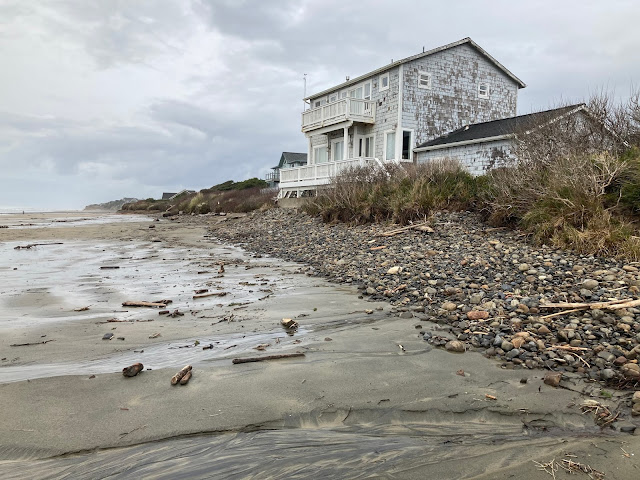We have had several periods of dry and sunny weather, lately, and with the longer days I feel more spring in my step. I even mowed the yard yesterday in blazing sunshine. Well this morning, it's back to rain again. Rainfall totals so far: 90.9 inches since July 1st, and 46.4 inches since January 1st.
;
Friday, we took advantage of the late afternoon minus tide. On the beach was this fierce looking fish, injured, but still alive. I first thought, "Barracuda?" That didn't seem right. A Google search when we got home proved it to be a Longnose Lancetfish. It is rare for them to be seen on beaches, but apparently they are fairly common offshore. They live between a depth of 6,000 feet and the surface. They can reach a length of a little over 6 feet. This one was about 4 feet long.
Gail was not too confident in my route finding skills, and her expression says it all.
I spotted this large scat at the top of the ridge above our house. I'm leaning cougar, as the diameter is a little too big for bobcat. It is not twisted like coyote scat, and you can see definite Tootsie Roll segments indicative of a feline. It was also not deposited in a conspicuous spot or latrine common to bobcats and coyotes.
One of the first native flowers to bloom around here is Skunk Cabbage.
The plant's pungent odor attracts pollinators, and its tuberous roots were used as food by Native Americans. The leaves will grow up to 3 feet long by summer.
A few weeks ago, I discovered that a woodrat was living in our pumphouse. I found its nest in a cardboard box of sprinklers on a shelf. The whole area was soaked in urine and feces, but the nest itself was beautifully constructed of moss. It had to go! I set my Have A Heart trap with a big glob of peanut butter, and the next day caught the little trouble maker. It is a Bushy-tailed Woodrat, not really a rat but a neatoma, its own kind of rodent. Adults are 17 inches long from nose to tail tip. I let it loose way down the road.
Forest Beauty
Hello! What we have here is a Northwestern Salamander that was under a pile of vegetation I was moving from the yard. They are a rather large salamander, reaching over 8 inches in length. They have large glands behind their eyes that make and secrete a poisonous fluid they smear on their bodies if threatened. They can also regenerate limbs if one is lost.
The End

























